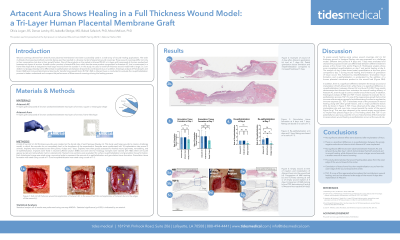Laboratory Research
(LR-028) Healing of a Rat Full Thickness Wound Model with Artacent AC, a Tri-Layer Human Placental Membrane Graft
Friday, April 28, 2023
7:15 PM - 8:30 PM East Coast USA Time

Babak Safavieh, PhD; Mora Melican, PhD; Denae Landry, BS; Isabella Sledge, MD
Introduction: Wound coverings derived from human placental membranes have been successfully used in a wide array of wound healing applications. The wide variety of processing methods currently being used has resulted in a market full of diverse placental wound coverings that have differences not only in their compositions but also in the amount of retained growth factors. One product currently on the market is Artacent AC, a tri-layer graft composed of chorion sandwiched between two layers of amnion. In this study, we assessed Artacent AC in a full thickness wound model in Sprague Dawley rats to understand the influence this wound coverings has on a healing wound.
Methods: Full thickness wounds were created on the dorsal side of each Sprague-Dawley rat. Implants were harvested at 4 days and grossly assessed for healed wound geometry, remodeling and re-epithelization.
Results: Implants were fixed in neutral buffered solution (NBS). Samples were stained with H&E. Stained cross sections were evaluated for surface re-epithelialization, cellular infiltration, and remodeling.
Discussion:
Methods: Full thickness wounds were created on the dorsal side of each Sprague-Dawley rat. Implants were harvested at 4 days and grossly assessed for healed wound geometry, remodeling and re-epithelization.
Results: Implants were fixed in neutral buffered solution (NBS). Samples were stained with H&E. Stained cross sections were evaluated for surface re-epithelialization, cellular infiltration, and remodeling.
Discussion:

.png)
